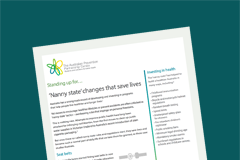A case for ‘nanny state’ changes that save lives
Laws to improve public health have long been criticised as the 'nanny state' but often the public accepts the changes because they save lives.
Laws to improve public health have long been criticised as the ‘nanny state’ but often the public accepts the changes because they save lives. This PDF factsheet argues in favour of rules that are often criticised as infringing civil liberties.
Examples of ways the ‘nanny state’ has helped to build a healthier Australia include childhood immunisation programs, bicycle and motorcycle helmet regulations, speed limits, shatterproof safety glass for showers, fire retardant children’s nightwear, public smoking bans, a minimum legal drinking age, mandatory smoke alarms and SunSmart regulations in schools and childcare centres.
Read our factsheet for greater detail and statistics on three successful historical examples: seat belts, random breath testing and cigarette packaging.
